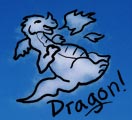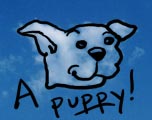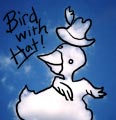
It is a beautiful Tuesday morning and I am sitting at home... sick. Instead of wasting my day, I decided to try to post another blog in between sneezes. Since I discussed the book
Little Cloud in my last post, I thought I would discuss
It Looked Like Spilt Milk this time around. I am also "killing two birds with one stone" since I am planning on using this book tomorrow with our little pre-K group. These books go well together since they both visit the idea of cloud shapes. The main difference is that "spilt milk" story has more shapes to look at and identify, and it doesn't tell you it is talking about clouds until the very end of the book. If you are not familiar with this book you can check out the youtube link below to see a video of it being read.
Our pre-k group consists of 3-4 three year old boys with communicative disorders. They are high energy kiddos. Our main focus with these boys is teaching them how to interact appropriately with one another: sharing toys, playing together, requesting items (instead of grabbing out of the other child's hands), waiting, taking turns, sitting in a short circle time (without hitting, kicking, getting up, etc.), and attending/participating in the story time. So I will choose some of the easiest activities that will work with short attention spans.
Here are some of the targets/goals that can be readily pulled from this book:
- Perceptual skills: Let the kids look at the pictures and guess the shapes. Most of the shapes will be easy to guess. Add to this, if desired, by making your own additional shapes out of tagboard or felt pieces. Can use a grab bag to pull out shapes and decide what they might be.
- Vocabulary: Naming the items in the book or game (above).
- Categorization: Group items - What animal shapes were in the book? What food shapes, etc?
- Articulation: /l/ sound - "looks like". Any sound can be addressed if you add an appropriate carrier phrase. You could also follow up the book by having the children make their own take home books and add the criteria that all of their cloud pics contain their target sounds. (Ex. /s/ blends - skate, skunk, spider, snail, smoke....). They can practice in single words by naming pics or in sentences by inserting the target into the repetitive text. A fun oral motor game (found in the Preschool Express link below): Use Straws and cotton balls to play a game of "blowing the cloud around the table". (Or, if you are really brave, blow white paint around on blue paper).
- Repetitive text / Verbal expression: "It looked like a (car) but it wasn't a (car)." This allows the child to fill in the new word in the first and/or second slot, similar to an early cloze exercise. It also makes it easier for the child to learn the carrier phrase which is actually a compound sentences 10 words in length.
- Grammatical skills: Highlight (say with added emphasis) any grammatical target needed:
Articles:
a car.
Pronouns:
it
Past tense verb: look
ed,
wasn't
Negation: was
not - teach about negation
Conjunction:
but - introduce "but" as a contrasting idea.
Temporal concept / adverb:
Sometimes - can discuss the difference
between "always" and "sometimes" in the context that the cloud
changes shape.
Art activities:
Tear paper into shapes.
Glob white paint on paper and see what shapes you end up with.
Glob white paint on blue paper, fold and decide what shape emerges.
Shaving cream paint: One of my new favorites! Mix equal parts shaving cream
and Elmer's glue, stir, and paint. Dries like a white puffy paint. Great for clouds.
Can also do the folded paper trick with this.
Stamping clouds: Use large stampers (I know have these somewhere) and use white
paint to stamp shapes onto blue paper.
Tracing shapes: Best for older kids. Trace around tagboard or other shapes.
Cotton Balls: Can fill in the shapes with cotton balls.
Sensory Play:
Shaving cream: Use bare hands to move shaving cream into shapes. Change shapes
into other shapes.
White playdoh or clay: shape into the book shapes.
Finger paint white shapes.
Pull batting or pillow filler material into cloud shapes. Can even glue onto tag.
Pinterest: One of my friends pinned this recip e and it looks perfect to go along with this book. Use 8 cups of flour mixed with 1 cup of baby oil. Makes a really soft "moon sand" for sculpting clouds and such.
Songs:
The Wind Moves the Clouds (tune of "The Farmer in the Dell")
The wind moves the clouds,
The wind moves the clouds,
And when it does they change their shape,
The wind moves the clouds.
Clouds are Floating (to the tune of Frere Jacques)
Clouds are floating, clouds are floating,
Up so high, up so high,
Floating up above us, floating up above us,
In the sky, in the sky.
CLOUD RIDDLE
What is fluffy?
What is white?
What can you see
When skies are bright?
What can float?
What brings rain?
What may be higher?
Than a bird or plane?
Say it loud:
CLOUD!
* You could also make up riddles about the shapes:
What is furry?
What is white?
What has long ears?
What can hop?
RABBIT
Science: Make a Cloud
1. Need hot water (not boiling), glass bottle, thin piece of cloth, rubber band, crushed ice.
2. Pour hot (not boiling) water into a glass bottle. When the bottle becomes hot, pour out all but one inch of water.
3. Stretch a thin piece of cloth over the mouth of the bottle and fasten it with a rubber band.
4. Place crushed ice on top of the cloth. Have children observe the cloud that forms as the warm air meets the cold.
Links: Check out the links below for more great ideas.
youtube video story
Preschool Express Cloud Theme
Story patterns at Kidzclub.com
Weather Wiz Kids info about clouds
Clouds Power Point Displays for those who really want to dive into clouds with older kids.












